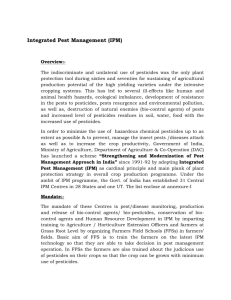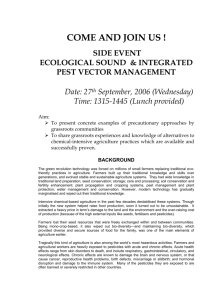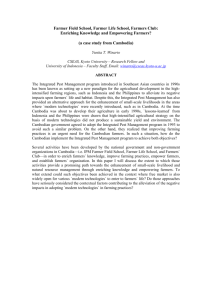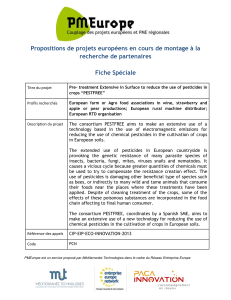PAN Europe`s answers to the impact assessment on which Common
advertisement
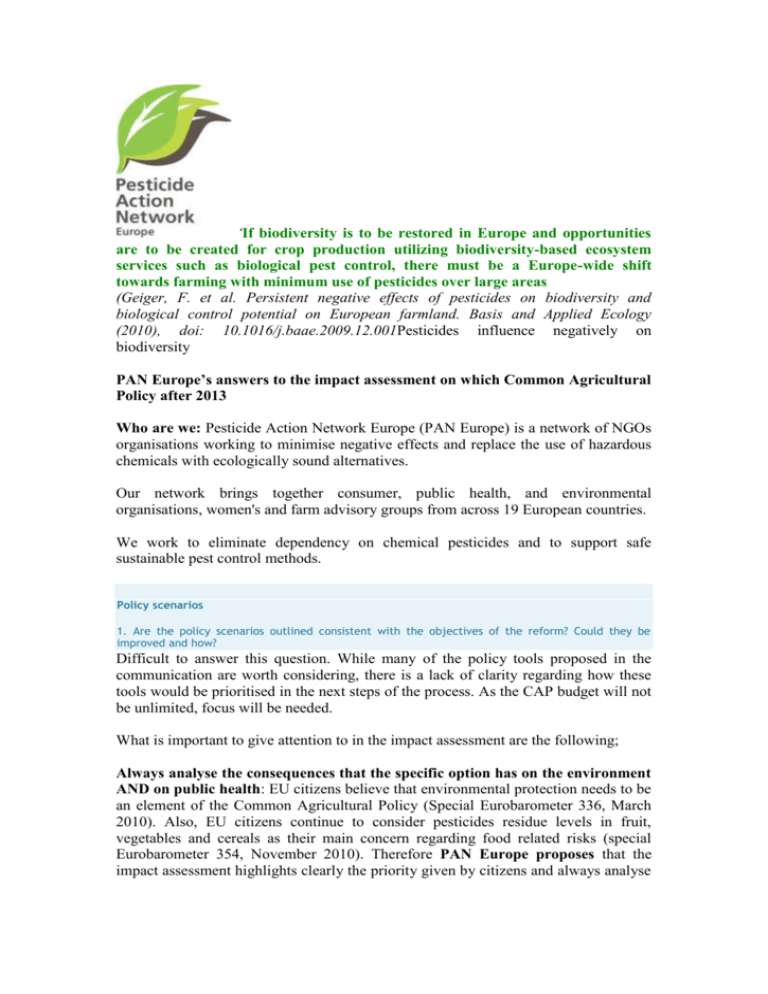
‘If biodiversity is to be restored in Europe and opportunities are to be created for crop production utilizing biodiversity-based ecosystem services such as biological pest control, there must be a Europe-wide shift towards farming with minimum use of pesticides over large areas (Geiger, F. et al. Persistent negative effects of pesticides on biodiversity and biological control potential on European farmland. Basis and Applied Ecology (2010), doi: 10.1016/j.baae.2009.12.001Pesticides influence negatively on biodiversity PAN Europe’s answers to the impact assessment on which Common Agricultural Policy after 2013 Who are we: Pesticide Action Network Europe (PAN Europe) is a network of NGOs organisations working to minimise negative effects and replace the use of hazardous chemicals with ecologically sound alternatives. Our network brings together consumer, public health, and environmental organisations, women's and farm advisory groups from across 19 European countries. We work to eliminate dependency on chemical pesticides and to support safe sustainable pest control methods. Policy scenarios 1. Are the policy scenarios outlined consistent with the objectives of the reform? Could they be improved and how? Difficult to answer this question. While many of the policy tools proposed in the communication are worth considering, there is a lack of clarity regarding how these tools would be prioritised in the next steps of the process. As the CAP budget will not be unlimited, focus will be needed. What is important to give attention to in the impact assessment are the following; Always analyse the consequences that the specific option has on the environment AND on public health: EU citizens believe that environmental protection needs to be an element of the Common Agricultural Policy (Special Eurobarometer 336, March 2010). Also, EU citizens continue to consider pesticides residue levels in fruit, vegetables and cereals as their main concern regarding food related risks (special Eurobarometer 354, November 2010). Therefore PAN Europe proposes that the impact assessment highlights clearly the priority given by citizens and always analyse the consequences on the environment and public health, as that is what EU citizens want. Calculate, where possible, the alternatives costs for a not application of the precautionary principle (in neoclassical terms referred to as negative externality): the impact assessment must as much as possible include calculation of alternative costs paid by citizens for EU policies not taking a preventive approach. For instance, a study by Pretty, J and Waibel, H (2005) ‘Paying the price: the full cost of pesticides’. In: The Pesticide Detox. Towards a more sustainable agriculture, Ed J Pretty, Earthscan, London, pp 39-54A in the UK and Germany conservatively estimated annual external costs of pesticides use to be US$257m and $166m respectively paid by their victims, the environment and citizens. Choose a solid reference year as the base of the impact assessment: The choice of reference year is fundamental when calculating trends. For instance, a study by Thomas L. Dobbs and Jules Pretty (2008) ‘Case study of agri-environmental payments: The United Kingdom’ published in Ecological Economics 67 pp : 765-775’ states that ideally, evaluations would be able to establish baselines that give indications of what would have happened overtime without the policy. Agricultural prices are fluctuating, though, in the CAP impact assessment it is important to include that farm income has actually increased by 12% in 2010, reminding first of all new entrants that the farming sector in the EU does have a future. Illustration of the importance of choice of reference year: It is important to choose a ‘fair’ year of reference when estimating trends. For instance, the communication specifies on page 4 that ‘the use of farm inputs, there has been a substantial decline from the fertiliser consumption peak of the seventies and eighties (by 2017 projections show a decrease of 28% for nitrogen compared to 1988, 67% for phosphorus and 61% for potassium in the EU-27 compared to 1979). If instead this calculation would have been using the early 90s as reference year the percentage would have been much lower (see fertilizers Europe forecasts of food, farming and fertiliser use 2009-2019). 2. Are there other problems apart from those set in the problem definition section of this document that should be analysed when considering the architecture of the CAP in the post 2013 period? What causes them? What are their consequences? Can you illustrate? One major problem is not addressed – widespread monoculture cultivation. Monoculture is not been addressed as a specific problem neither in the communication nor in the consultation document, even though that this production form causes ecological damages (N-leaching, loss of biodiversity, erosion, monotonisation of landscape, manifestation of pests and diseases) and economic threads (subvention for growing energy-plants leads to increased tenure/lease prices and penalise farmers who are growing arable crops in rotation). Even though lack of diversified cropping systems is recognised as a major cause of high levels of pest, disease and weed problems, requiring increased pesticide inputs. Expanding crop rotations is key to promoting biodiversity and more resilient farming systems, with reduced reliance on agrochemicals. Two problems with definitions from the consultation paper: Our understanding of food security is different from the one mentioned in the consultation document. On page 2 the paper states ‘In effect, short-term survival dominates the perception of many farmers over the long-term, broader perspective. If agricultural policy does not address the former, it will have little success in promoting the latter.’ Also, our understanding of prevention is different than the one mentioned in the text. On page 3 (paragraph 3) it says ‘strengthening the principle of prevention in animal and plant production, the strengthening of surveillance and a more riskmanagement based approach across the food chain.’ We instead believe: Farmers should be paid for taking agronomic preventive measures to prevent biodiversity from declining, pests from spreading and climate from changing… This requires strong public support, not cosmetic green-washing. The real problem: Many farmers are reluctant to swap short-term certainty for longer-term sustainability. It is hard to undertake a change when being part of a chemical dependent system and part of a supply chain which demands uniform size, consistency and perfect appearance of crops. The way forward: The only way forward is a smooth transition to a CAP which supports farmers financially, technically and morally in using safer farming methods and alternative treatments. Such a CAP will not only meet the need to produce healthy foods for Europe’s citizens, but also help to address the serious environmental problems of climate change, water contamination, soil degradation, biodiversity loss and declining bee populations. Such a transition is the best solution for the health of society and our farmers as it will: (a) contribute to create greater political stability, more active citizen support for the farming and rural sectors and (b) help to build more resilient production systems which are less vulnerable to pests, diseases, and extreme weather and more climatefriendly - a win-win situation for all in the longer run. The solution is at hand: The consultation document and the impact scenario outlines does not seem to take account of the fact that from 2014 it will be mandatory for all EU farmers to apply IPM at farm level. EU Directive 2009/128/EC on the sustainable use of pesticides requires all EU farmers to apply Integrated Pest Management (IPM) as from 2014. Article 14 states: “Member States shall take all necessary measures to promote low pesticide-input pest management, giving wherever possible priority to non-chemical methods, so that professional users of pesticides switch to practices and products with the lowest risk to human health and the environment among those available for the same pest problem. Low pesticide-input pest management includes integrated pest management as well as organic farming according to Council Regulation (EC) No 834/2007 of 28 June 2007 on organic production and labelling of organic products.”. With Article 14.4 specifying that IPM is to be applied by all farmers. This is a unique opportunity to start the journey to encourage more sustainable agricultural practices, away from monoculture, standardisation and unsustainable intensive production, enabling farmers to diversify and shift to safer farming methods and alternative treatments, to reach the longer term objective where only sustainable agriculture receives public funding. 3. Does the evolution of policy instruments presented in the policy scenarios seem to you suitable for responding to the problems identified? Are there other options for the evolution of policy instruments or the creation of new ones that you would consider adequate to reach the stated objectives? The report ‘Ecophyto R & D vers des systems de culture economes in produits phytosanitares volets 1’ elaborated by the French ministry of ecology and the French ministry of agriculture calculate the costs of the farmer from input reductions in different scenarios, showing that many farmers will have an increased profit by application of IPM though input costs savings. Application of green components will help to reduce the costs linked to inputs further until a certain tipping point, where further reductions will have marginal costs for the farmer. The calculations done in this report must be included into the considerations in the impact assessment. Certain types of farming is not doing anything to deliver environmental and public health benefits, it is time to start eliminating these kind of production methods from obtaining public support (inspired by the Swiss example where farmers need to prove to deliver public goods in order to obtain public funding). This can be done by start defining banned practices in GAEC. Establishment of independent advisory services in all member states is fundamental to guide farmers in the spirit of environment and public health conservation. Impacts 4. What do you see as the most significant impacts of the reform scenarios and the related options for policy instruments? Which actors would be particularly affected if these were put in place? The communication asks on page 8 ’Can agriculture do it?’ then explaining about income related aspects’. Maybe a more appropriate question would be ‘can the environment and public health do it’? The main innovation: The green component of direct payments proposed in the integration option is the key to success. Crop rotation helps to create a biodiverse soil which reduces the chance of soil-borne organisms to reach damaging levels and therefore reducing the use of pesticides. Crop rotation helps to minimise the growth of unwanted plants and avoid high pressure from weeds that need to be eradicated and therefore reducing the use of herbicides. Crop rotation helps achieve a good soil structure (alternatively shallow and deep rooting roots), high organic matter, good water provision, especially in combination with conservation tillage, resulting in a higher yield. Crop rotation, especially performed with nitrogen-fixing rotation crops (beans and peas), will reduce the input of fertilizers and so reduce air pollution by nitrogenous greenhouse gases (studies show that high nitrogen-supply can actually deplete soil organic matter (S.A.Khan et al. J. Environ. Qual. 36:1821-1832, 2007: “The myth of nitrogen fertilization for soil sequestration”) pointing to the role of high N-fertilizer use as a reason for carbon depletion). Crop rotation, especially combined with conservation tillage, will lead to higher soil-carbon content and so contribute to combating climate change ( proven in decade-long surveys in the US, Illinois, see Annex, and also by research, L.M.Vleeshouwers et al. Global Change Biology 8:519-530, 2002: “Carbon emission and sequestration by agricultural land use: a model study for Europe”). Cover crops are excellent for combating erosion, be it water or wind erosion. Cover crops keep the soil protected against water and wind and keep soil structure intact. Cover crops also help to keep humus elements protected against oxidation and to reduce release of carbon to the air. Cover crops also act as catch crops preventing nutritious elements like nitrogen from draining and reduce the need for fertilizers. Cover crops finally promote soil biodiversity through better structure and better protection against drying and oxidation. The enhanced soil biodiversity in turn will help keep soil pest levels low and reduce the use of pesticides. Permanent coverage helps against erosion, structure loss, drying out, oxidation and reduction of soil biodiversity. This will help keep soil structure intact and soil nutrient available. As a result the yield will be better next year and less use of fertilizers and pesticides are needed. It contributes to combating climate change. Ecological set aside, understood as buffer zones to watercourses, helps prevent pesticides and fertilizers getting directly into water courses and damaging aquatic ecosystems. Good spraying management remains important too. Buffer zones, if managed well, e.g. allowing wild herbs, could also be of use for beneficial organisms in crop growing to reduce the use of pesticides. In case of orchards large buffer zones are necessary. Crop rotation, cover crops, ecological set aside and permanent pasture: each of these instruments, especially in combination, are of significance in ensuring proper pest management, making maximum use of natural control processes. This goes hand in hand with the fact that all farmers are to apply IPM according to the EU Directive 2009/128/EC on the sustainable use of pesticides, as from 2014, and can significantly help to ensure protection of the environment and public health, if implemented as a mandatory package for each EU farmer to apply. Application of green components will help to reduce the costs linked to inputs until a certain tipping point, where further reductions will have marginal costs for the farmer. The report ‘Ecophyto R & D vers des systems de culture economes in produits phytosanitares volets 1’ elaborated by the French ministry of ecology and the French ministry of agriculture calculate the costs of the farmer from input reductions in different scenarios, showing that many farmers will have an increased profit by application of IPM though input costs savings.. 5. To what extent will the strengthening of producer and inter-branch organizations and better access to risk management tools help improve farmers’ income levels and stability? We welcome the idea of strengthening the role of producer and inter-branch organisations, but highlight also that environmental and consumer organisations can help to improve the bargaining power of farmers: Who do citizens trust? (Special Eurobarometer 354, November 2010) other than identifying EU citizens’ views on food risks (see answer one) also includes a survey on Public confidence in sources of information on food safety. The survey shows that EU citizens are the most confident in “their physician/doctor”, “family and friends” and then “consumer organisations” (76%), “scientists” (73%) and “environmental protection groups” (71%). The wide majority of Europeans feel confident about “farmers” (58%) with respect to information on food risks. These are the only actors in the food supply chain that reach a level of confidence above 50%. Results show that respondents tend to trust information from those involved in the food supply chain to a much lower degree, with about a third saying they feel confident about information from “food manufacturers” (35%) and “retailers” (36%). Role for environmental and consumer organisations: Page 10 of the consultation document states ‘Consumers and stakeholders do not seem to be sufficiently well informed about the characteristics and production methods that define the quality of products, with information and promotion activities becoming an important marketing tool.’ Environment and consumer organisations, can help to create more diversification, and as a result more diversification in prices, along the food chain too. Finally, while in strict economic thinking, all elements of food’s intrinsic quality should be covered by the market price, imperfections in the food chain caused by the many suppliers and the few retailers, limits farmers’ options for quality diversification as a tool to obtain a higher market price. We therefore think that the CAP should contain elements allowing quality diversification, boosting organic production and also developing a specific new EU definition for Integrated Production, to support change in mainstream farming that are long overdue. Better Access to risk management tools: The integration scenario mentions ‘A wider range of risk management instruments will be offered to farmers, helping them to cope with price and production risks (including those related to animal and plant health) through better access to insurances, mutual funds and income stabilisation instruments.’ We propose the European Commission to study new farm insurance systems which do not discriminate against farmers operating reduced pesticide plans (paradoxically more virtuous farmers using less pesticides are excluded by the schemes) and better support farmers to cope with possible additional production risks incurred by adopting IPM, agro-ecological systems, and organic farming (e.g. lower yields in some situations). 6. What environmental and climate-change benefits would you expect from the environmenttargeted payments in the first and the second pillar of the CAP? In a post 2013 CAP, farmers wishing to receive public funding should be obliged to provide individual project plans identifying how they will apply sustainable agricultural practices in an approach of ‘prevention first’, and how - for the farmers who wishes to - to move towards more natural agro-ecosystems. CAP support must be offered to the farmer/land manager as a package of measures to match development of a sustainable agricultural project. It is also the time to change the spirit of the CAP, by enabling pioneers, away from an approach of business as usual and into an approach of rewarding and motivating those farmers who ‘go the extra mile’ and encourage the rest to take the first steps up the IP ladder to safer and more sustainable farming. The traditional ‘pillars’ approach of the CAP should be redesigned into effective building blocks, asking the single farmer to develop a mandatory package of sustainable practices (crop rotation, cover crops and ecological set aside for arable crop growers: permanent pasture, cover crops and ecological set aside for pluriannual farming and grassland), adding on a number of voluntary elements that farmers should be encouraged to go even further in delivery of more sustainable practices and methods (also, but not exclusively, by use of new technology and new knowledge). 7. What opportunities and difficulties do you see arising from a significant increase of the rural development budget and a reinforcement of strategic targeting? In the current CAP success of transition in European agriculture depends to a large extend on Member States’ willingness to establish a technical, financial and moral support framework guiding farmers into delivering more sustainable practices, helping them to gain confidence in using less agrochemical input. In compliance with the EU Directive 2009/128/EC on the sustainable use of pesticides, Member States should provide necessary technical support in the form of: early warning systems for key pests and diseases; IP advisory systems and training for farmers and agronomists etc. However, in whatever form the rural development policy will take in the future, it is important the European Commission inspire Member States and regions, encouraging them to upgrade their rural development plans regularly, by feeding in with new ideas such as: Increase awareness of new EU law, e.g. make Member States now aware of the EU Directive 2009/128/EC on the sustainable use of pesticides, proposing them to offer farmers, at least temporary, public funding for adoption of non-chemical alternatives Propose new ideas such as to protect citizens in the rural areas, for instance proposing establishment of ‘public health buffer zones’ to protect rural inhabitants from being exposed to pesticides in their home, and in their local surrounding; rural tourists from being exposed to pesticides while coming to the countryside for an rural experience; children from being exposed while waiting for the bus, playgrounds in schools.. Allowing member states to exchange ideas on Integrated Crop Management, to take a more dynamic approach to farming, on farming going beyond the mandatory package of green components, for instance as part of the European network for rural development, though within some kind of ranging system (which is not the case now), e.g. informing about cases on Integrated Production system in Emilia Romagna where farmers grow kiwis extensively – without spraying – in the area bordering neighbours. 8. What would be the most significant impacts of a "no policy" scenario on the competitiveness of the agricultural sector, agricultural income, environment and territorial balance as well as public health? NA Monitoring and evaluation 9. What difficulties would the options analysed be likely to encounter if they were implemented, also with regard to control and compliance? What could be the potential administrative costs and burdens? It is inevitable that administrative costs and burdens will increase with a CAP based on delivery of a set of green mandatory components. Though, if we want to keep the CAP in the longer run it is fundamental to link the money to delivery of services. Following the model from organic farming, and asking each farmer to deliver an annual plan, against which they might be controlled, will not only ensure more prevention but also help the farmer start reflection on why he or she is receiving public funding. So, in short, an exercise of benefits to all if we want to raise the profile of the potential that the farming sector has in delivering benefits to society. More control and compliance will also allow more collection of data, which will then also make it easier for the national and/or regional administration to explain to the general public why public money is given to farmers and make clearer what benefits it delivers for the environment and public health. 10. What indicators would best express the progress towards achieving the objectives of the reform? EU citizens believe that environmental protection needs to be an element of the Common Agricultural Policy (Special Eurobarometer 336, March 2010). Also, EU citizens continue to consider pesticides residue levels in fruit, vegetables and cereals as their main concern regarding food related risks (special Eurobarometer 354, November 2010). Therefore PAN Europe proposes that the impact assessment highlights clearly the priority given by citizens and always analyse the consequences on the environment and public health. Of specific indicators to measure environment and public health we propose to consider measuring use of input through introduction of the Frequency Treatment Index (currently being used in Denmark and France). It is important to develop indicators able to measures implementation of the Water Framework Directive (Directive 2000/60/EC of the European Parliament and of the Council of 23 October 2000 establishing a framework for Community action in the field of water policy) ensuring that quality goals have to be applied also for small water bodies, like small rivers that are frequent in agricultural areas) Where possible, calculate the alternatives costs for a not application of the precautionary principle (in neoclassical terms refered to as negative externality): the impact assessment must as much as possible include calculation of alternative costs paid by citizens for EU policies not taking a preventive approach. For instance, a study by Pretty, J and Waibel, H (2005) ‘Paying the price: the full cost of pesticides’. In: The Pesticide Detox. Towards a more sustainable agriculture, Ed J Pretty, Earthscan, London, pp 39-54A in the UK and Germany conservatively estimated annual external costs of pesticides use to be US$257m and $166m respectively paid by their victims, the environment and citizens. 11. Are there factors or elements of uncertainty that could significantly influence the impact of the scenarios assessed? Which are they? What could be their influence? NA For further information: Henriette Christensen, senior policy advisor, PAN Europe Brussels office tel: + 32 2 503 08 37; email: henriette@pan-europe.info Pesticide Action Network Europe (PAN Europe) was founded in 1987 and brings together consumer, public health, and environmental organisations, trades unions, women's groups and farmer associations from across 19 European countries. PAN Europe is part of the global network PAN working to minimise the negative effects and replace the use of harmful pesticides with ecologically sound alternatives. Number in the EU register of interested parties : 15913213485-46


